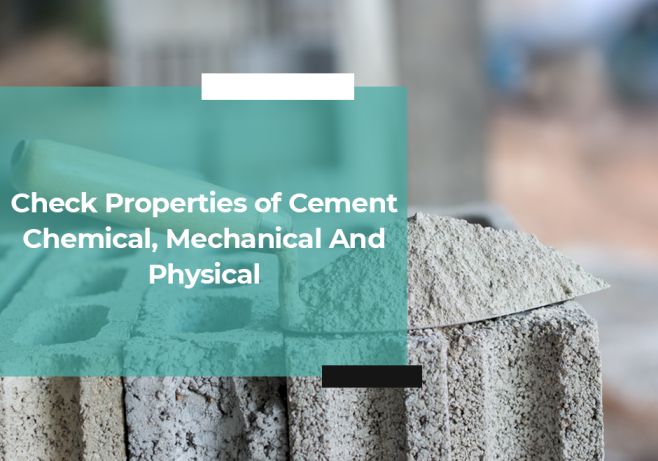Cement is a fine grey powder that is used to form mortar or concrete when combined with water and other ingredients. It’s an important component of both residential and commercial construction. Cement is a crucial part of urban infrastructure. It’s used to manufacture concrete and mortar and safeguard infrastructure by tying the building blocks together. Cement, water, sand, and gravel are mixed in specific amounts in concrete, whereas cement, water, and lime aggregate are utilized in mortar.
Cement’s qualities are fully determined by its composition, fire, and grinding. The following are some of the most important properties of good cement:
Strength:-
After 7 days, the compressive strength of cubical blocks made of conventional Portland cement and sand (1:3) should be at least 175 kg/cm2.
Fineness:-
The fineness attribute of cement determines its quality. As a result, excellent Cement should suffice. A sieve test can be used to measure the fineness of the cement. It is also possible to test the Cement by touching it, and it should be smooth.
Soundness:-
The cement of all varieties expands to some extent, depending on its composition, correct burning, and grinding. After setting, a fine quality cement should not have a significant volume change. It should also not crack or crumble after being set.
7 Physical Properties of Cement:
Physical properties distinguish different types of cement mixtures used in construction. Cement quality is influenced by a few important variables. Good cement has the following physical characteristics:
- Fineness of Cement:
The particle size determines the fineness of the cement. Grinding the clinker achieves the required fineness of good cement in the final phase of the cement manufacturing process. Cement fineness is critical as cement hydration rate is directly proportional to cement particle size. - Soundness:
Soundness refers to a cement’s ability to resist shrinkage after it has hardened. Excessive free lime and magnesia cause delayed expansion, which is why good quality cement maintains its volume after it has set.
- Consistency:
Consistency is the ability of cement paste to flow. The Vicat Test is used to determine it. In the Vicat Test, a regular consistency cement paste is used in the Vicat Apparatus. The plunger of the equipment is lowered till it touches the cement’s top surface. Depending on the consistency of the cement, the plunger will penetrate it to a particular depth. - Strength:
Compressive, tensile, and flexural tests are used to determine the strength of cement. The water-cement ratio, cement-fine aggregate ratio, curing circumstances, specimen size and shape, molding and mixing methods, loading conditions, and age are all elements that influence the strength.
- Setting time:
Cement sets and hardens when sufficient water is added to it. The time it takes for cement to set is determined by a number of factors, including the fineness of the cement, the cement-water ratio, chemical content, and the presence of admixtures. The initial setting time of construction cement should be as short as possible, and the final setting time should be as long as possible. As a result, two setting times are recorded: When the paste begins to stiffen visibly, this is the initial set. When the cement hardens, it will be able to support some weight. - Heat of Hydration:
When water is added to cement, it undergoes hydration, which is a chemical reaction. Hydration produces heat, which can affect the quality of the cement and aid in keeping the curing temperature stable in cold weather.
- Bulk Density:
When you mix cement with water, the water fills in the spaces that would normally be filled with air. As a result, cement bulk density isn’t as important as it used to be. Cement density varies depending on the percentage of cement in the mix. Cement can range in density from 62 to 78 pounds per cubic foot.
11 Different Type of Chemical Properties of Cement:
Cement is composed of essential materials like limestone (calcium), sand or clay (silicon), bauxite (aluminum), and iron ore, as well as other elements such as shells, chalk, marl, shale, clay, blast furnace slag, and slate. Chemical examination of cement raw materials reveals information about cement’s chemical properties.
- Tricalcium aluminate (C3A)
- Tricalcium silicate (C3S)
- Dicalcium silicate (C2S)
- Ferrite (C4AF)
- Magnesia (MgO)
- Sulphur trioxide
- Iron oxide/ Ferric oxide
- Alkalis
- Free lime
- Silica fumes
- Alumina
Different Types of Mechanical Properties of Cement:
Mechanical properties like shrinkage and creep, compressive strength, tensile strength, flexural strength, and modulus of elasticity are used to evaluate the performance of concrete.
Compressive Strength
Split Tensile Strength
Flexural Strength
8 Types Properties of Concrete Cement:-
- It gets a lot of tensile strength.
- It is corrosion-free, and atmospheric agents have no discernible influence on it.
- It hardens with age, and the hardening process continues for a long time after the concrete has reached its maximum strength. Cement concrete has a unique feature that distinguishes it from other building materials.
- It has been proven to be more cost-effective than steel. This is due to the fact that sand and pebbles or crushed rock, which make up roughly 80 to 90 percent of cement concrete, are frequently accessible at a reasonable price. After the formwork, which is made of steel or wood, is removed, it might be reused or used for other purposes.
- It quickly bonds to steel, and because it is weak in tension, steel reinforcement is inserted in cement concrete at strategic locations to absorb tensile stresses. Reinforced Cement Concrete, or R.C.C., is the name given to this type of concrete.
- It has a proclivity towards being permeable. This is due to the presence of voids that emerge during and after the installation process.
- It hardens into a surface that can withstand abrasion.
Check This Out: How is Portland Pozzolana Cement Made? Uses of PPC Cement

